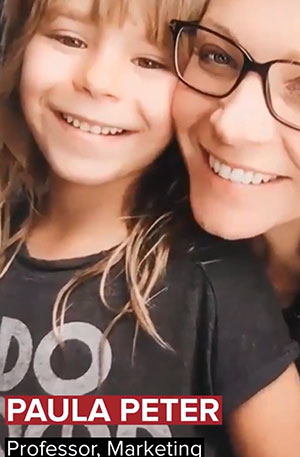Dr. Paula Peter Offers Technology Tutoring for Fowler Faculty
Faculty Peer Support: Dr. Paula Peter Offers Technology Tutoring for Fowler Faculty
In early March, SDSU faculty - including the faculty at SDSU’s Fowler College of Business - were asked to move their classes to virtual instruction due to the COVID-19 crisis.
Fowler marketing professor, Dr. Paula Peter, became well-versed with virtual instruction when she started to teach online every summer three years ago. To help Fowler faculty members who were new to the online process and to provide a hand to the IT department at SDSU, Peter initiated weekly one-hour Zoom support sessions for FCB faculty to discuss best practices on conducting tests, posting grades, recording lectures, and capitalizing on online resources. Faculty were encouraged to attend live so that they could participate in the conversation and recordings of the sessions were shared with the college.
We asked Peter about her efforts surrounding the “FCB Virtual Instruction Support Sessions” and here’s what she had to say:
Q: What motivated you to help your fellow faculty members learn more about online
instruction?
A: The opportunity to help my colleagues re-energizes me. It is a great feeling to know
you have helped someone, plus it’s allowed me to meet new people and learn new skills
myself. Providing help and support to each other allows us to serve our students’
best interests and it builds and strengthens our SDSU community.
Q: How have the faculty at the Fowler College of Business adapted to virtual teaching?
A: They have been extraordinary, especially the ones who were new to the technology
and the online environment. Overall, the Fowler faculty and lecturers have shown extreme
strength, motivation, and willingness to learn so that they can provide the best learning
experience for our students.
Q: We know this new method of instruction can bring some challenges, but have you
found any unique opportunities resulting from your online instruction experience?
A: I know it sounds counterintuitive, but I feel the online environment and Zoom have
allowed me to connect at the individual level with more students than face-to-face.
When we were on-campus, I would announce open office hours, but only a few students
would show up and at the end of class only few, usually the regular ones, would stop
by for a conversation. The ability to create breakout rooms with Zoom and to schedule
online group, as well as individual meetings, have given me the opportunity to get
to know more of my students.

Peter has been teaching at SDSU and homeschooling her daughter Alice (left) during the COVID-19 pandemic
Q: Adapting to the “new normal” has offered you some personal challenges as well.
Since your husband is an intensive care unit (ICU) nurse, can you discuss how his
quarantine has impacted your life?
A: My husband is currently isolated on one side of the house in order to avoid potential
contamination. We have two kids (aged 5 and 8) in two different school systems and
homeschooling is no joke! But we manage with a structured daily plan that still allows
for flexibility and free time while making sure everything gets done. I feel that
in times of crisis, there is a lot of comfort in maintaining routines and we made
sure to establish those very early on. Still, I cannot wait for homeschooling to be
over and for the end of my husband’s isolation, so he does not have to wear a mask
also at home anymore.
Q: Finally, do you have any words of advice or encouragement to faculty as they continue
to adapt to virtual learning?
A: Be willing to take risks and try new things. You can always make adjustments along
the way. Also, do not be afraid to ask for help. I once read that “asking for help
isn’t giving up – it’s refusing to give up.” Remember, there are plenty of resources
available and an army of educators going through the same experience you are, so there
is a very high probability that someone has already an answer to your question. And
when you get the opportunity to help and/or share, do so – it comes with immense,
and often, unexpected positive rewards such as a boost of happiness and gratitude.
Lastly, be authentic and genuine with your students and take the time to connect with them. Make sure you establish a rhythm and provide consistency in the way you deliver your course content. I truly believe our students are going to get a stellar education because of our faculty’s tenacity and their willingness to explore these new online opportunities and what the virtual world has to offer.

